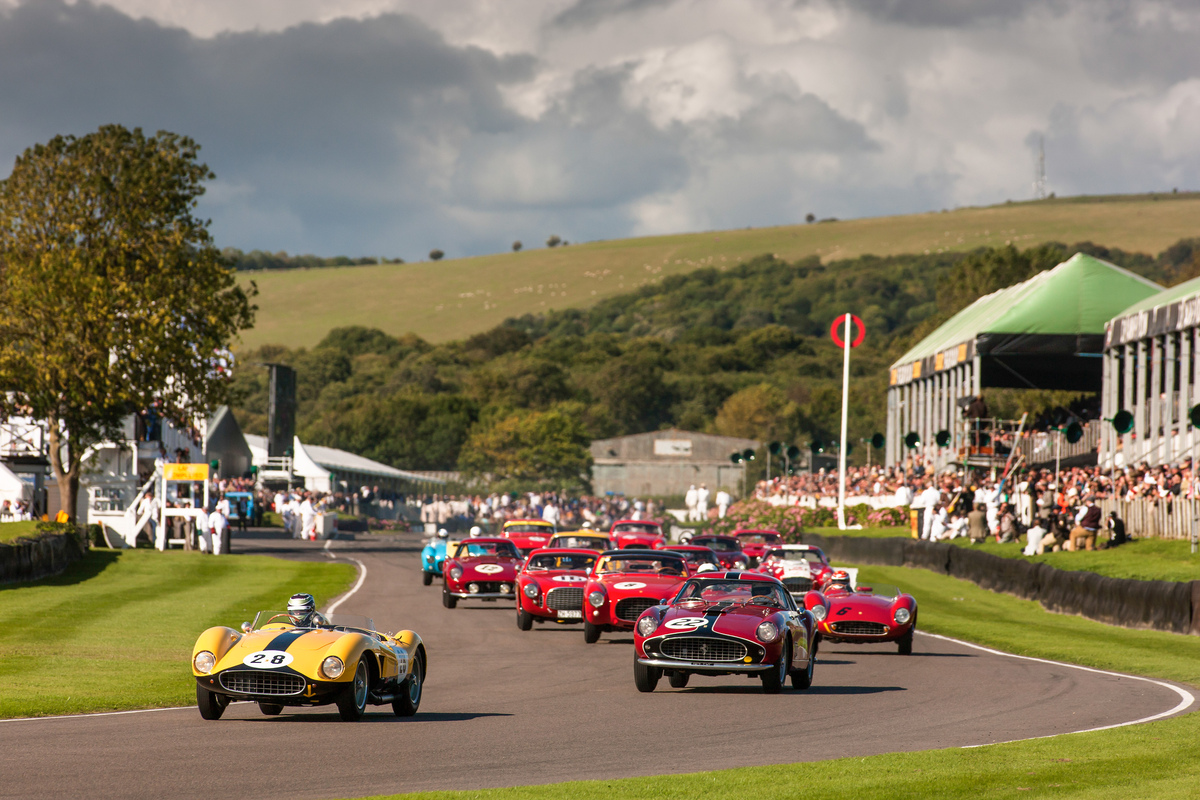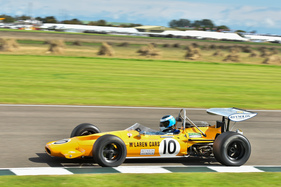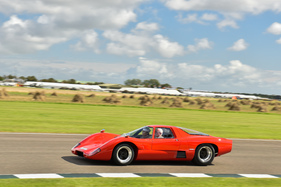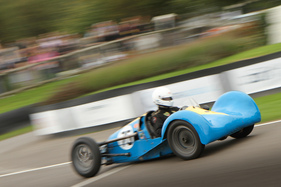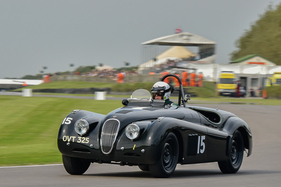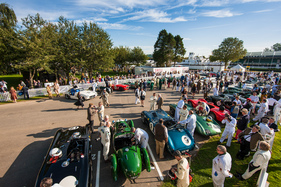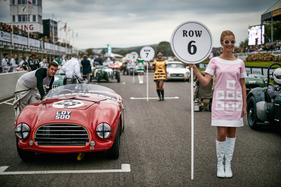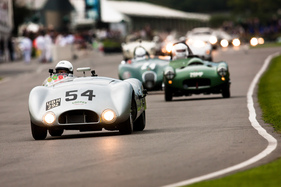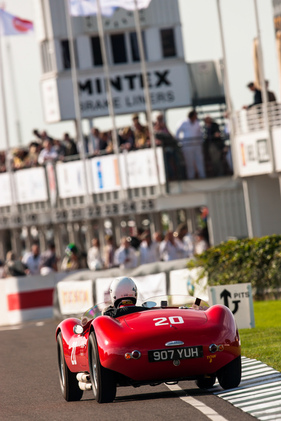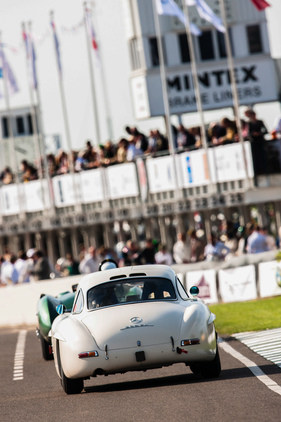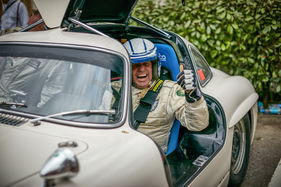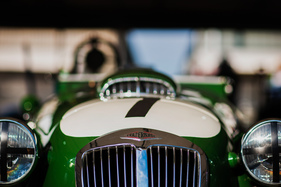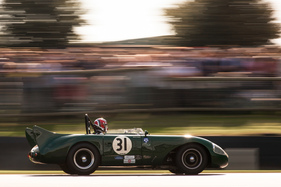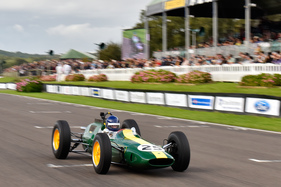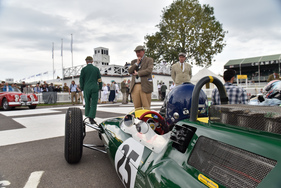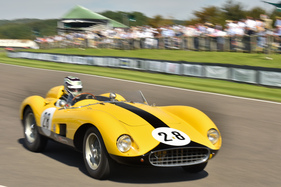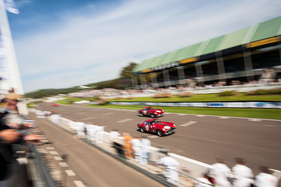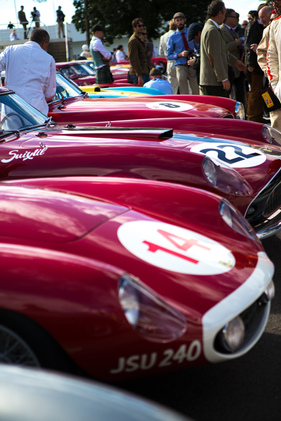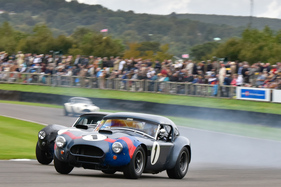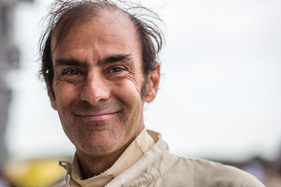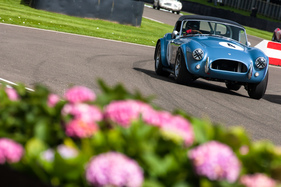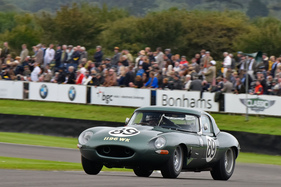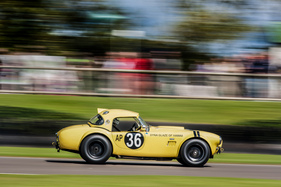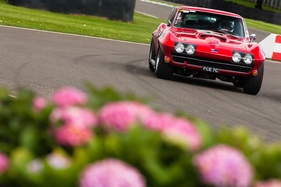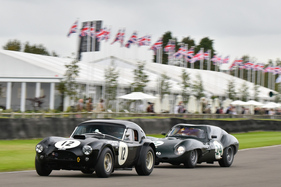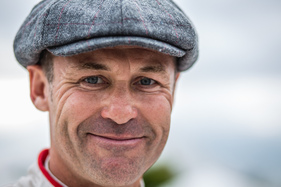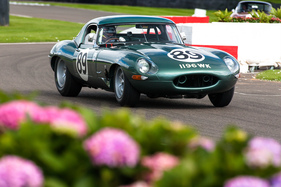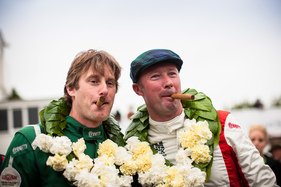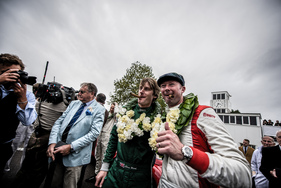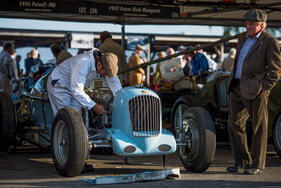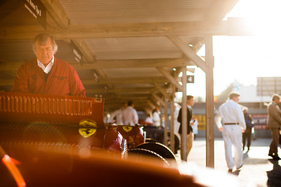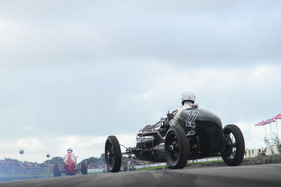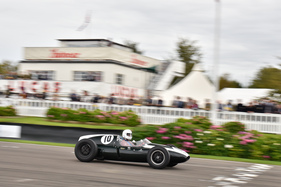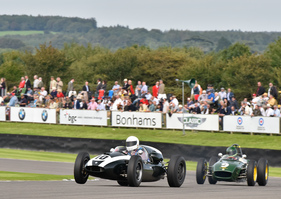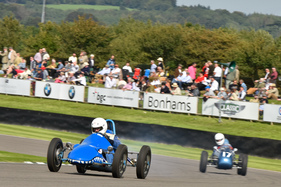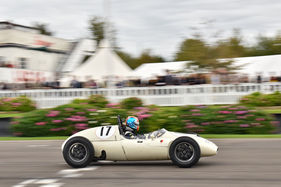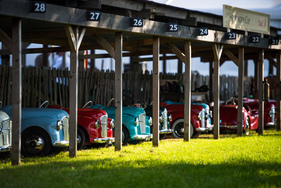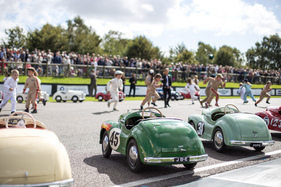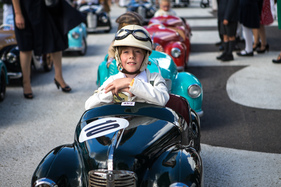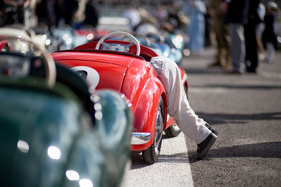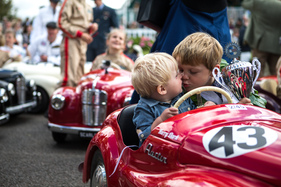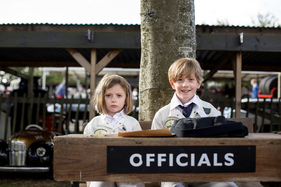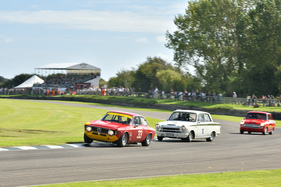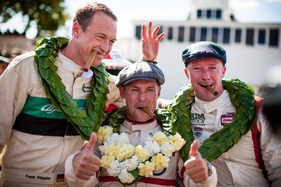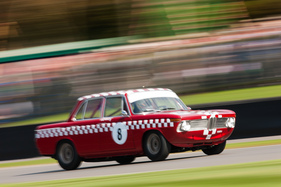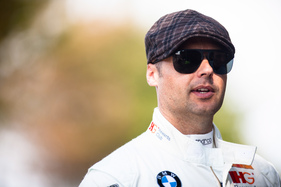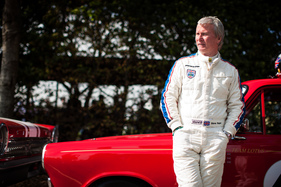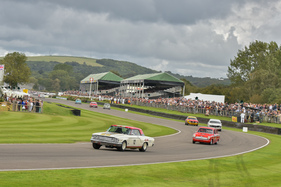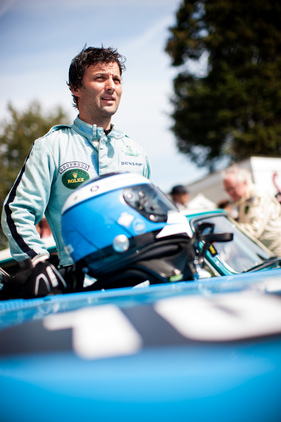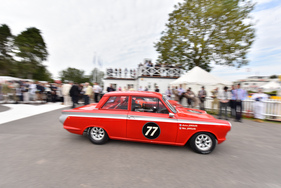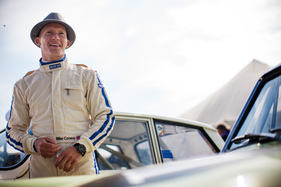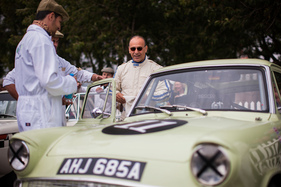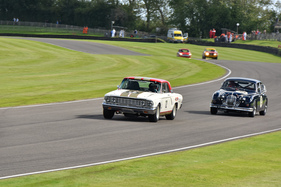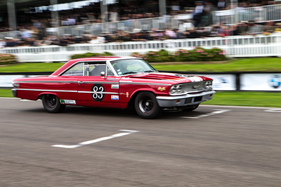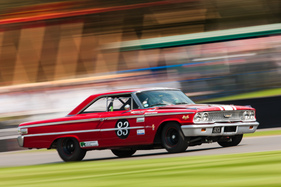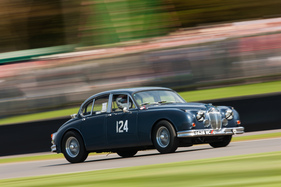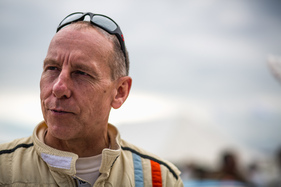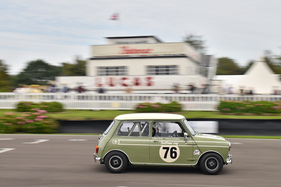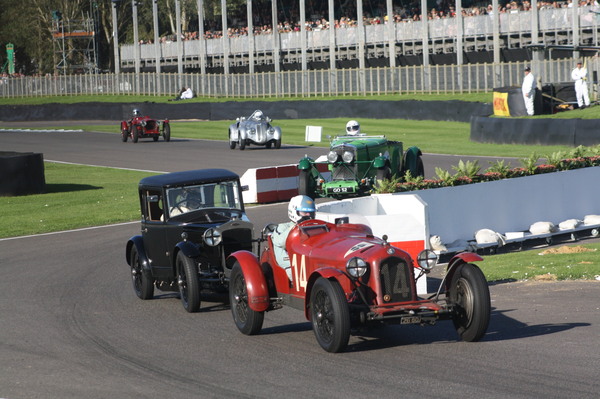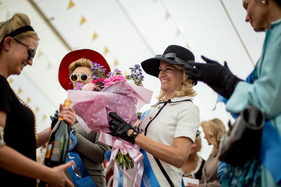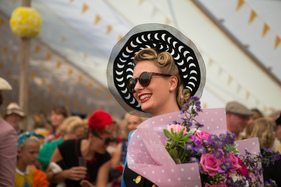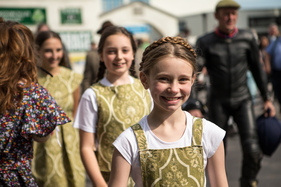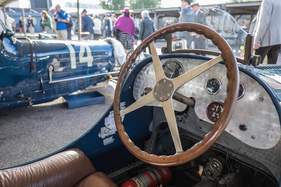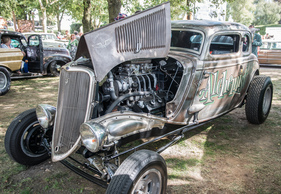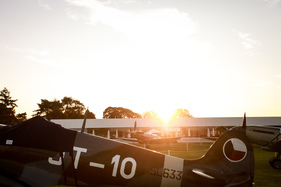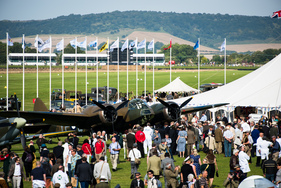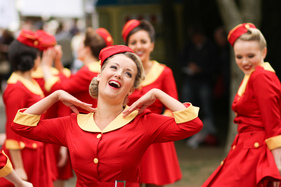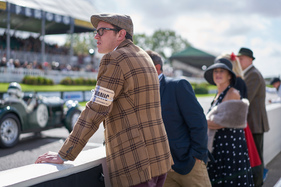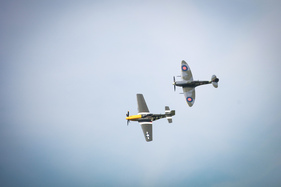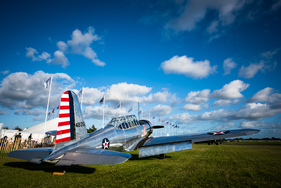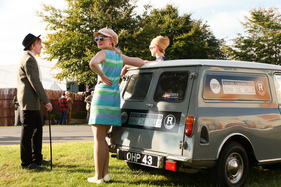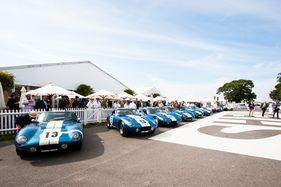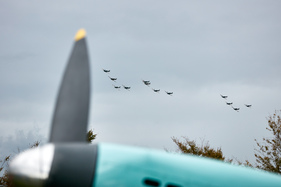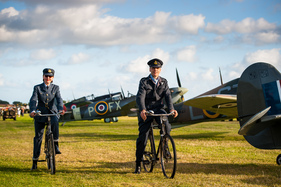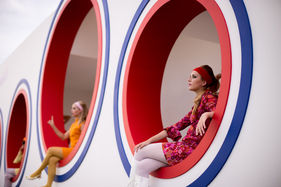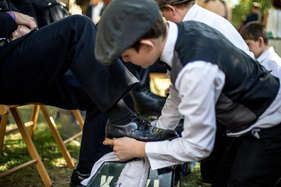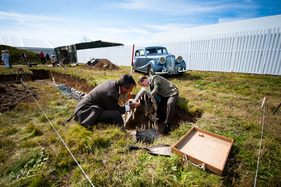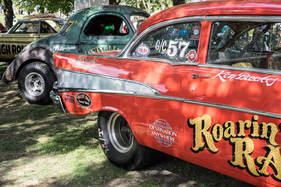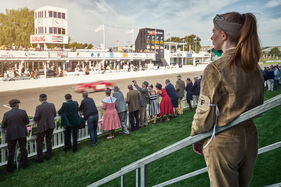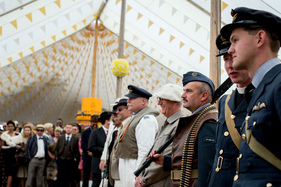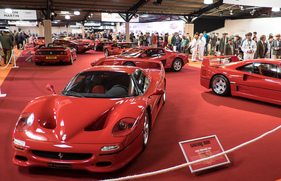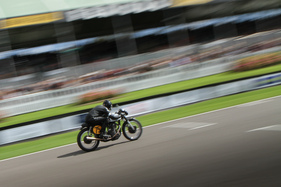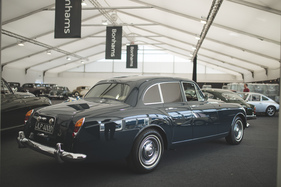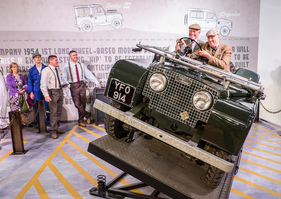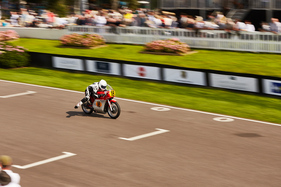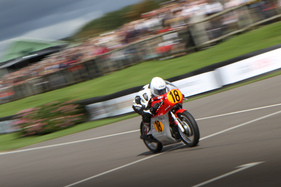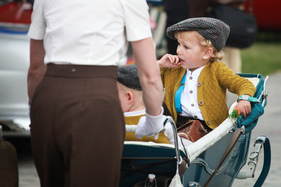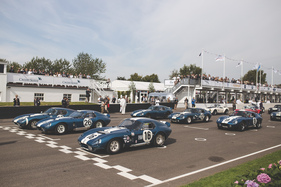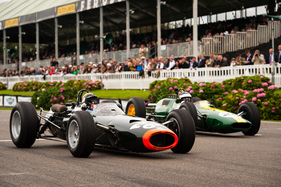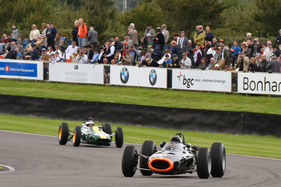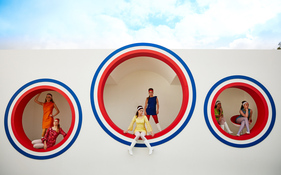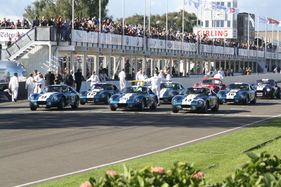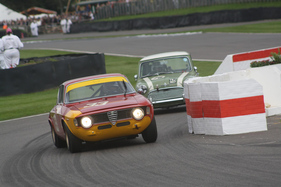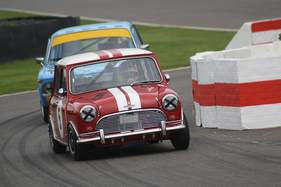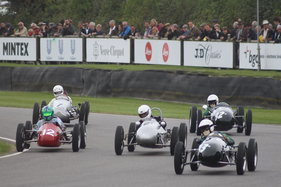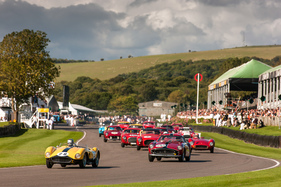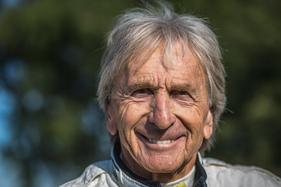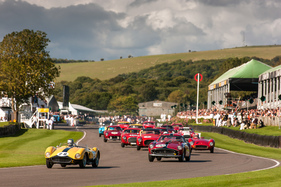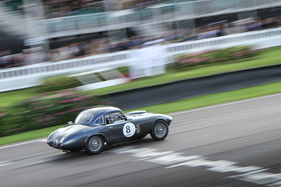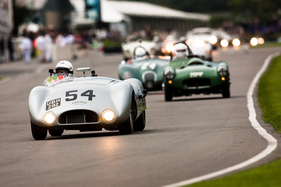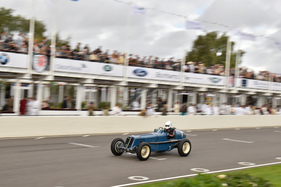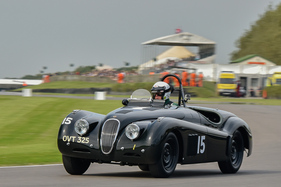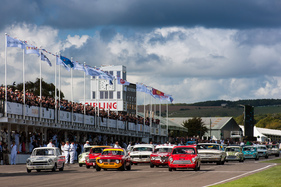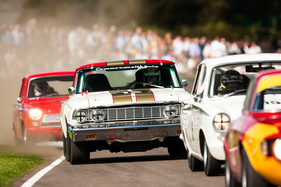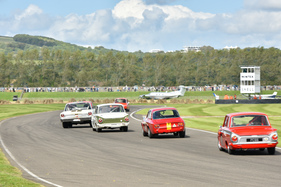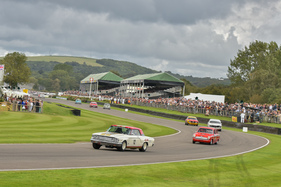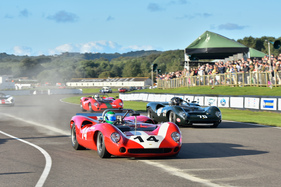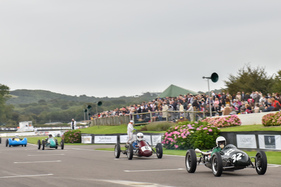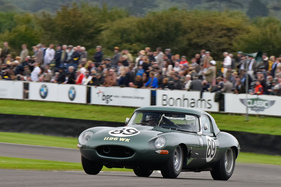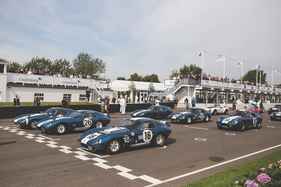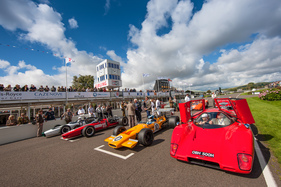Since 1998, the Earl of March and Kinrara has been inviting people to the large grounds in West Sussex in the south of England to revive the historic Goodwood Motor Circuit, which was renovated with his money and opened by his grandfather Freddie March on September 18, 1948. National and international races in various classes were held here until 1966. After that, Goodwood was just a testing ground before the aristocrat had the entire infrastructure faithfully restored and came up with the idea for what are now three unique events.
Since then, Goodwood - the Members' Meeting on the circuit in March, which was only re-established in 2014, the Festival of Speed in Castle Park in July and the Revival Meeting back on the circuit in September - has been regarded as the Mecca of Historic Racing.
No coffee run
The Revival Meeting is anything but a leisurely demonstration of the good old days. It stands for "pure racing" - but not only that. Nowhere else on the planet are classic cars (including a number of newly built histo vehicles) driven so fast and so many former heroes and contemporary professionals can be seen at the wheel or as invited guests in the audience. There is no more authentic event for historic racing; everything in, on and around the circuit symbolizes that era, from the snack bar to the paddock to the cars and the spectators who dress nostalgically. This is theater in action.
Only the racing drivers' modern helmets and overalls "disturb" the revitalized zeitgeist, but safety comes first. The spectators have long since become accustomed to the fact that there are more wheel-to-wheel battles and overtaking maneuvers in practically all of the 16 different races for cars from the Goodwood era than during an entire GP season.
That's why they are prepared to shell out the equivalent of hundreds of francs for general admission and grandstand seats. Incidentally, tickets are only available in advance and usually sell out weeks in advance. Those who don't want a covered seat can make themselves comfortable on the green hills surrounding the 2.38-mile circuit.
And all of them - a total of around 149,000 over three days - were lucky last weekend in view of the uncertain weather forecasts, as they were practically spared rain for three days. Only those who stayed until the end of an otherwise sunny Friday evening had to seek shelter from the rain.
From Saturday morning onwards, it was and remained dry despite some dark clouds, although - according to us Central Europeans - it was quite cool and windy at times. This didn't stop some ladies from presenting themselves lightly clad and allowing a glimpse of their cleavage.
And if you were in the mood to buy a racing or sports car with revival potential, you could head to the Bonhams auction on Saturday .
Victory with the boss
However, our main focus was on the action on the track. This began after the practice sessions on Friday with the Freddie March Memorial Trophy, an endurance race for racing cars that recreated the spirit of the legendary Goodwood Nine Hours from 1952 to 1955. Instead of nine hours, this race, contested by 29 cars, lasted 90 minutes. British driver Chris Ward, who works full-time as workshop manager at JD Classics and is allowed to drive his boss Derek Hood's cars solo or together with him, was in a class of his own.
After Ward had put the Cooper-Jaguar T33 from JD Classics on pole position with a 4-second lead (!) over brand colleagues Keen/Kyvalova, his boss Derek Hood lost a few positions as the starting driver. After taking over the 1954 sports car, Ward quickly plowed his way through the field and was already back in the lead at the halfway point. When a heavy rain shower fell in the last half hour, some competitors skidded off the track through the grass, including Ward, but most were able to continue their journey.
The slippery surface even suited the former Silverstone race instructor and track manager so well that he lapped the entire field at least once before the finish! Second place went to the RGS-Jaguar Atalanta of Nuthall/Wood, third place to the fast Katarina Kyvalova in her Cooper-Jaguar T33, which she handed over to Briton Philip Keen for half the distance.
A race for all the senses
Equally impressive was Mark Gilles' performance in the first 20-minute race on Saturday morning, which was reserved for GP cars and Voiturettes from 1930 to 1950. Those who witnessed it live not only enjoyed the sight and sound of these fast pre- and post-war vehicles, but also soaked up the "stench" that was blown into the spectator stands by the wind and caused by the special fuel mixture - wonderful!
In qualifying, the Briton had to make do with four flying laps and a time that was only good for fifth place due to a technical problem. After two laps, Gilles was in the lead in his green 1934 ERA R3A, where he extended his lead over Calum Lockie, who had started from pole position in the 1938 Maserati 6CM, to over 15 seconds. His fifth and so far most emotional victory in the Goodwood Trophy, as his father had died the previous week. Nicholas Topliss, who had catapulted his one year younger ERA R4A into the lead at the start, finished third, just ahead of Michael Gans in the ERA B-Type of the same age.
A feast for the eyes and ears at the Revival Meeting is always the Alfa Romeo 308C with Julian Majzub, which is unique in this field and was eighth and last to avoid being lapped by Gilles. The best German-speaking representatives were Heinz Bachmann (ERA R9B from 1936) and Klaus Lehr (Talbot-Lago Type 26C from 1948) in 11th and 14th place.
Trotters on the trot
The three podium places in the next race, the Fordwater Trophy for near-series sports and GT cars from 1948 to 1954, were also quickly decided. As the clear pole setter, John Young soon shook the well-known British journalist Chris Harris out of the slipstream of his Jaguar XK120 and won after 20 minutes with a 10-second lead over the latter's Porsche 356. This was Young's fourth Revival victory, the second in the GT cars.
As third with the fastest race lap (in the final round), Philip Champion at the wheel of a Frazer Nash Mille Miglia more or less lived up to his name, because anyone who is allowed to hang one of the three laurel wreaths to be awarded at the Revival after a race feels like a champion.
Christian Traber did a respectable sixth place in his Fiat 8V Zagato, which he was driving in a race for the first time. "It doesn't have that much power, but it's very nice to drive on this fast track," said the famously fast garage owner from Toffen.
The fact that the cars are the stars at Goodwood and not primarily their drivers was proven by the discreet appearance of musician Chris Rea in this field. Although he was eliminated in his 1955 Lotus-Ford VI, he had a great time at the event. Instead of concert stages, the hobby racer and family man will now be seen more often at such events.
What a spectacle!
The St Mary's Trophy for touring cars is one of the annual highlights of the Revival Meeting, but Part 1 with professionals and stars from the world of racing at the wheel of the 60s touring cars exceeded all expectations. This was not least due to this year's date, which for years has been in mid-September between the Italian and Singapore Grand Prix. This time, the revival also did not clash with any rounds of the popular British Touring Car Championship, meaning that some of the BTCC drivers were able to demonstrate their skills in historic racing cars. First and foremost this year's champion Gordon Shedden.
The 36-year-old Scot took pole position in a Ford-Lotus Cortina Mk1 with a lead of 18 hundredths of a second over Frank Stippler's Alfa Romeo GTA and 45 hundredths over his BTCC colleague Andrew Jordan in another Cortina. This trio fought a thrilling battle for the lead that had the fans on the edge of their seats.
Meanwhile, Tom Kristensen rolled up the field from the back, having only covered around 400 meters in the Ford Fairlane Thunderbolt in practice due to an electrical fault. With lap times well below Shedden's pole time, TK inexorably approached the leading trio, which he eventually caught up with. Apart from the undisputed driving skills of the nine-time Le Mans winner, the three more agile 1600 touring cars were no match for the power of the 7-liter V8 engine under the hood of the Thunderbolt. "No chance of stopping him," said Shedden in second place, "but I still had a lot of fun with Frank and Andrew." The German lost some ground in the various attacks by Cortinas or in counter-attacks due to two short rides over the grass, but was still able to salvage third place with Alex Furiani's GTA.
The winner himself owed his success primarily to his team, Alan Mann Racing, who had worked overtime to get the Fairlane running for the race. "The fact that I was able to win from the back of the grid obviously speaks volumes for the car. But my brakes and tires were pretty much at the end afterwards. I certainly benefited from the experience I had here two years ago with a comparable Ford Galaxie, so it wasn't so bad that I didn't get to drive in practice," the Dane told us.
The list of other drivers below the podium reads like a who's who of motorsport with the likes of Andy Priaulx (three-time WTCC champion), Jackie Oliver (both BMW 1800 TISA), Mat Jackson and Steve Soper (both Cortina Lotus), etc.
The man himself
In Sunday's Part 2, it was mainly the turn of the talented car owners and other professionals, and Henry Mann - one of the two sons of the legendary team boss who passed away in 2012 - did not show any weakness either. Starting from the front row alongside Shedden's BTCC colleague Matt Neal in the Cortina and Bill Shepherd's Ford Galaxie, Mann soon took the lead in his first race with the Fairlane and pulled away from his pursuers. While Shepherd dropped back with his big ship, Matt Neal and Mike Jordan (Andrew's father) fought it out for second place with their Cortinas. Alex Furiani had to let Richard Shaw's BMW 1800 TISA go with a dented rear end, but was lucky to at least keep the small infernal Morris Cooper S of tuner/driver Nick Swift behind him to the finish.
After adding up the two 25-minute races, Kristensen/Mann won by 5 and 8 seconds respectively ahead of the two British Cortina duos Shedden/Neal and Jordan/Jordan as well as Stippler/Furiani in the Alfa Romeo GTA.
Just how much better the British cars are than those of their European rivals was demonstrated by the example of the two original historic BMW Classic Group works cars. Neither Prince Leopold of Bavaria/Jörg Weidinger in the Austin Cooper S nor Lucas Luhr/Adrian van Hooydonk in the BMW 1800 TISA from Munich had the slightest chance against the cars of their brand colleagues, which had been optimized with every trick in the book. "You can keep up in the corners, but they pull away from you on the straights," said Jörg Weidinger, who has already won with many modern BMW racing touring cars, shrugging his shoulders.
Respect lost
There were 23 different Ferraris from the 1950s in the Lavant Cup. The only thing they had in common was their drum brakes, which probably makes this race unique for all time. In view of their inestimable value, most of the drivers went about their work rather cautiously. Only James Cottingham, in his father's 500 TRC, and Carlos Monteverde, a well-known collector and racing driver, in his 750 Monza, entered into a real duel. Cottingham seemed to have lost a little respect, as he caused a slight collision between the two in the lead duel with Monteverde.
The contact with the enemy would not have been necessary, as the Brazilian was given a 10-second time penalty for a jump start anyway. "That can happen, hopefully he'll forgive me," said the young Briton, somewhat crestfallen as the winner. It goes without saying that Monteverde was not on his best behavior afterwards...
Behind Max Girardo's 250 GT Tour de France, two other 500 TRCs driven by Emanuele Pirro (four-time LM winner with Audi) and Joe Macari, all more than a minute behind, finished fourth and fifth. Christian Traber was the second-best GT driver in his 250 GT Europa after 20 minutes in a good sixth place. The fastest and slowest of these drum-brake Ferraris were separated by almost 30 seconds per lap.
Fast owl
The star of the Brooklands Trophy field, whose cars commemorated the races on the legendary Brooklands Circuit until 1939, was an owl. As an animalistic English diminutive, this is the nickname of the 1928 Frazer Nash Saloon "The Owlet" by Patrick Blakeney-Edwards, which stood out among the open-top archaic racing cars with its shape and the sound of a very pithy-sounding touring car.
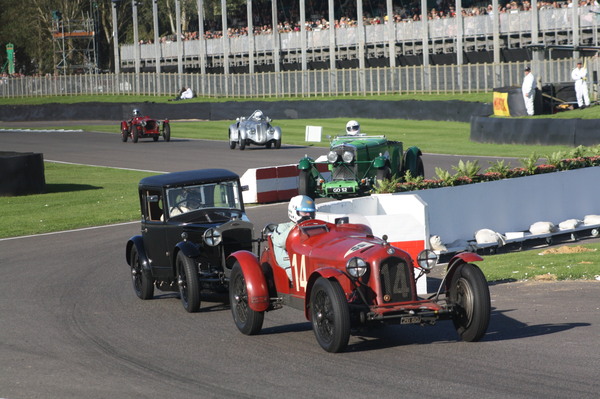
Starting in second place, after 20 minutes he finished third behind Neil Twyman's Alfa Romeo 8C 2600 "Muletto" and Gareth Burnett's Talbot AV105, which was clearly the fastest car in training.
The new record holder
The fastest and in every respect most brutal cars can be found in the Whitsun Trophy, which concluded the Saturday racing program. The 28 Spyders of the type familiar from the legendary CanAm series and other sports car races, interspersed with a few Ford GT40s, were a visual and acoustic treat. A heavy crash involving Tony Sinclair's Lola T70 Spyder led to a safety car period, and the race was shortened from 25 to 20 minutes because tire patches had to be repaired later on.
The fastest man at the 18th Goodwood Revival Meeting in 2015 was Nick Padmore in his 1966 Lola T70 Spyder. The Briton first took pole position with a time of 1'19.299 (= 174.8 km/h), then won the race ahead of brand colleague Oliver Bryant and Jay Esterer in the Canadian Chinook-Chevrolet Mk2 and also set the fastest lap of the weekend in 1'21.164 (171.31 km/h). He proved that he could be even faster in March at the Members' Meeting, where he set the fastest lap of all time as the winner of the Bruce McLaren Trophy Race in 1'18.2. The official lap record, excluding the Revival Meeting, is held by Formula 1 pilots Jim Clark (Lotus-Climax 25) and Jackie Stewart (BRM P2161), who each completed a race lap in 1'20.4 at the Sunday Mirror International Trophy Race on Easter Monday 1965.
The Glover Trophy, in which British Historic Racing professional Martin Stretton was on pole position on Sunday with 1'24.79 in the Lotus-BRM 24 and turned the fastest race lap in 1'24.062, is a reminder of that era and class at the Revival. This was not least due to today's stiffer chassis and the optimum compounds of the treaded racing tires. It didn't do him any good, as he spun into the grass in the battle with Andy Middlehurst and Nick Fennell in their Lotus Climax 25. Fennell ended up in the gravel in front of Stretton, allowing Middlehurst to take a solitary victory in the race for the 1.5-liter Formula 1 cars up to 1965.
On a collision course
At the other end of the performance and speed scale are the 500cc Formula 3 racing cars from 1948 to 1959, which only appear in such numbers and with such a variety of brands in front of a large audience every three or four years at the Revival Meeting. They opened the second day of racing under dark clouds, which never cleared throughout the day. As small as they are, the spectacle was huge, with countless overtaking maneuvers, slips, collisions and a hair-raising accident involving long-time leader George Sackleton on the home straight. The latter had fought a tough wheel-to-wheel duel with Peter de la Roche in the final laps, whereupon he risked everything again in the final chicane when attacking the young newcomer and lost. The 17-year-old Briton had only just taken the lead on the outside of the Woodcote corner and then celebrated his victory in his first race with the Cooper-Norton Mk5. With a time of 1'44.249, which corresponds to an average speed of 133.38 km/h, he also drove the fastest lap.
In the following race for GP cars from 1954 to 1960, the battle for victory was no less turbulent. Pole setter Julian Bronson only led for one lap in the Scarab Offenhauser before rolling out with a defect. Rod Jolley in the Cooper-Climax T45/51 and Roger Wills in the Lotus-Climax 16 then fought it out for victory. A very daring maneuver by Wills in the chicane, which was made of polystyrene walls and decorated with flower boxes, meant that he had to retire when he collided with a straggler on the way in. Rod Jolley, who had already stood on the podium at the first Goodwood Revival Meeting in 1998, then drove to victory unchallenged ahead of Gary Pearson in the BRM Type 25 (ex-Bonnier).
Jaguar ahead of Cobra pack
The one-hour RAC TT Celebration Race for GT cars from 1960 to 1964, heralded and praised as the highlight of every Revival Meeting, was soon decided. Frank Stippler had qualified the Squire family's AC Cobra for the best starting position, but with Michael Squire as the starting driver, the silver Cobra was never in front again. Instead, the aforementioned Chris Ward soon surged to the front, skillfully exploiting the potential of his boss's E-type. Five Cobras and a Tiger (Sunbeam Lister) chased a Jaguar that they never caught.
After the pit stop window opened from the 20th to the 40th minute, Ward immediately handed the Jaguar over to Gordon Shedden, who was once again uncatchable in the lead after each pairing completed their driver changes. With a lead of almost 15 seconds over the Cobra of Smith/Bryant, their victory - the first for a BTCC driver in the TT race - was clear, with Squire/Stippler in third place almost 43 seconds behind.
The Corvette Sting Ray of Davies/Gravett was the first non-British GT car to cross the finish line in tenth place, two laps down. The fastest of the four Ferraris (all with more historic charisma than the "modernized" Cobras and Jaguars) was the 250 GT SWB "Breadvan" of Ames/Halusa. Conrad Ulrich and Carlo Vögele brought Vögele's equally unique and valuable 330 GTO home unscathed in 21st place out of 24 GT cars classified and 28 that started.
Grandiose parades
Normally represented by one or two cars, the Shelby American Cobra Daytona Coupés formed a separate item on the program in an exhibition of a daily high-speed demonstration. Never before have all six Shelby coupes in existence worldwide, all in typical Azure Blue with thick white stripes, been gathered in one place. One, signed by Carroll Shelby, Bob Bondurant and Phil Hill, came from a museum in Philadelphia and reportedly has an insurance value of $15 million.
One of the daily parades featuring many notable race cars was dedicated to Bruce McLaren, who died 45 years ago at Goodwood while test driving a McLaren CanAm.
Those who still hadn't had enough of all this waited until after 6 p.m. on Sunday to watch the 16th and final race (there were two more for motorcycles). There was still a victory for the most prestigious sports car brand Ferrari (which the British probably don't like to hear). Bobby Verdon-Roe won the Sussex Trophy for sports cars from the 1955 to 1960 world championship seasons with a 246S Dino ahead of two Lister Jaguars and an Aston Martin DBR2.
